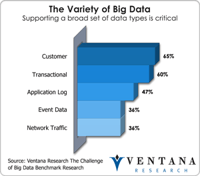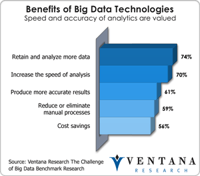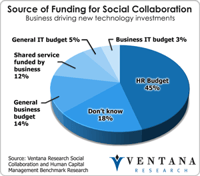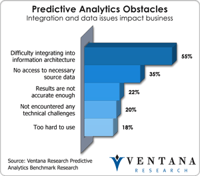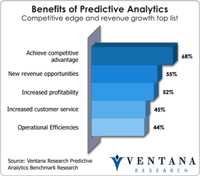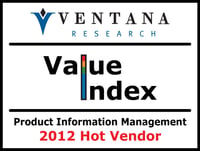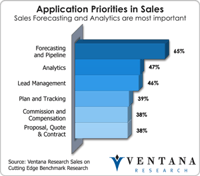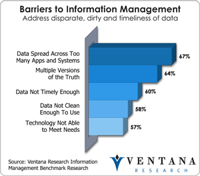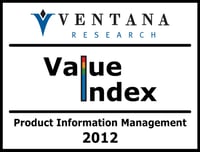Jaspersoft Business Intelligence Suite competes in the open source and broader BI market. Its customer base is mostly in the small and midsized business and OEMs and SaaS providers who can embed Jaspersoft code directly into their offerings. Earlier this summer, the company introduced Jaspersoft 4.7, which features advancements in interactive reporting, big data access and mobile business intelligence for Android. The 4.7 release brings interactive features such as segmenting and filtering,...
Read More
Topics:
Big Data,
Mobile,
Jaspersoft,
Operational Performance,
Analytics,
Business Intelligence,
Business Performance,
Cloud Computing,
Customer & Contact Center,
Information Applications
I had a refreshing call this morning with a vendor that did not revolve around integration of systems, types of data, and the intricacies of NoSQL approaches. Instead, the discussion was about how its business users analyze an important and complex problem and how the company’s software enables that analysis. The topic of big data never came up, and it was not needed, because the conversation was business-driven and issue-specific.
Read More
Topics:
Big Data,
Datameer,
Predictive Analytics,
Sales Performance,
Supply Chain Performance,
Planview,
SuccessFactors,
Operational Performance,
Analytics,
Business Analytics,
Business Intelligence,
Business Performance,
Customer & Contact Center,
Financial Performance,
IBM,
Information Management,
Operational Intelligence,
Workforce Performance,
PivotLink
After this summer’s SAS European analyst event, I wrote that I came away less than convinced SAS was truly committed to the cloud, based largely on the fact that most other vendors are blowing their cloud trumpets much louder than SAS. It seemed developments in and around customer intelligence and its other products were higher priority to the company than its cloud strategy. However, after a recent update, I was left with no doubt that the cloud is important to SAS and that the company has a...
Read More
Topics:
SAS,
Customer Analytics,
Customer Data Management,
Speech Analytics,
Voice of the Customer,
Operational Performance,
Analytics,
Business Analytics,
Cloud Computing,
Customer & Contact Center,
Call Center,
Contact Center,
Contact Center Analytics,
Desktop Analytics,
Text Analytics
One of the community groups to which I donate my time is an organization that puts on a Concours d’Élegance – a vintage car show. Such Concours date back to seventeenth-century France, when wealthy aristocrats gathered to see who had the best carriages and most beaudacious horses. Our Concours serves as the centerpiece to a broader mission of raising money for several charities. There a many such events in the United States and elsewhere, but this one, which has been held every year since 1956,...
Read More
Topics:
Big Data,
GRC,
IT Performance,
Operational Performance,
Business Analytics,
Business Intelligence,
Business Performance,
CIO,
Financial Performance,
Information Management,
Operational Intelligence,
CFO,
finance,
Talent Management,
FPM
IBM has announced its intention to acquire Kenexa as part of IBM Smarter Workforce initiative and social business software division. It’s a billion-dollar-plus investment to bolster IBM’s social business and give the company more depth in the human capital management software market that comprises human resources, talent management and workforce management. A lot of surface-level analysis I’ve seen on this announcement is not worth reading, but the deeper review below may help Kenexa and IBM...
Read More
Topics:
Sales Performance,
Social Media,
Supply Chain Performance,
Human Capital Management,
Kenexa,
Recruiting,
Operational Performance,
Business Collaboration,
Business Performance,
Cloud Computing,
Customer & Contact Center,
Financial Performance,
Governance, Risk & Compliance (GRC),
IBM,
Workforce Performance,
Talent Management
Our research consistently finds that defects in data are the root cause of a wide range of problems encountered by modern corporations. The magnitude of the problem correlates with the size of the company: Big companies have bigger headaches than midsize ones. Data issues diminish productivity in every part of a business as people struggle to correct errors or find workarounds. Issues with data are a man-made phenomenon, yet companies seem to treat bad data as some sort of force of nature like...
Read More
Topics:
Big Data,
Predictive Analytics,
Sales Performance,
Supply Chain Performance,
GRC,
IT Performance,
Operational Performance,
Business Analytics,
Business Intelligence,
Business Performance,
CIO,
Customer & Contact Center,
Financial Performance,
Information Management,
Operational Intelligence,
Workforce Performance,
CFO,
finance,
FPM
Midsize businesses “pay” for their use of entry-level accounting systems by not having the essential information they need readily available and by using up valuable time that could be better spent generating business, finding issues or responding to opportunities sooner or simply enhancing the efficiency of the organization. Nevertheless, the transition from an entry-level accounting package such as QuickBooks to an on-premises system can be daunting for companies whose entry-level software no...
Read More
Topics:
Sales Performance,
Customer Experience,
ERP,
Office of Finance,
end-to-end,
finance cloud,
Business Performance,
Cloud Computing,
Financial Performance,
Business Process Management,
CFO,
finance,
accounting software,
business process execution,
financial systems,
FPM
A study by the McKinsey Global Institute published earlier this year suggests a coming shortage of more than 140,000 workers with deep analytical skills and a shortage of more than 1.5 million data-literate managers. I’m not sure how the study defined these roles, but I’d guess that those with deep analytic skills are those folks building the complex models, and the data-literate managers are those executives, middle managers and analysts who interpret the results and use the models to help...
Read More
Topics:
Big Data,
Data Scientist,
Predictive Analytics,
Sales Performance,
IT Performance,
Operational Performance,
Analytics,
Business Analytics,
Business Collaboration,
Business Intelligence,
Business Performance,
Cloud Computing,
Customer & Contact Center,
Operational Intelligence,
Workforce Performance
In my last rant, on business analytics and the pathetic state of dashboards, I pointed out significant flaws in business intelligence software created by technology providers and in how it is being deployed by business and IT. Now I want to follow up with some insight on disconnects to a critical asset that is essential to the success of business analytics. I mean key performance indicators (KPIs), a term used in inaccurate ways that have diminished the value of the concept for business.
Read More
Topics:
Sales Performance,
Social Media,
Supply Chain Performance,
Sustainability,
KPI,
IT Performance,
Key Performance Indicators,
Operational Performance,
Business Analytics,
Business Collaboration,
Business Intelligence,
Business Performance,
Cloud Computing,
Customer & Contact Center,
Financial Performance,
Governance, Risk & Compliance (GRC),
Information Applications,
Information Management,
Location Intelligence,
Operational Intelligence,
Workforce Performance
The product page for Interactive Intelligence highlights what the company is best known for – IP-based business communications. This image is further strengthened by its flagship Customer Interaction Center platform, which offers organizations a fully featured multimedia contact center in the cloud. This offering includes multimedia communications in the cloud along with many of the capabilities that Ventana Research terms agent performance management. However, the company also offers a third...
Read More
Topics:
Customer Analytics,
Customer Experience,
Customer Feedback Management,
Speech Analytics,
Voice of the Customer,
Analytics,
Cloud Computing,
Customer & Contact Center,
Customer Service,
Call Center,
Contact Center,
Contact Center Analytics,
Desktop Analytics,
Interactive Intelligence,
Text Analytics,
Unified Communications,
Workforce Force Optimization
Over the last several months, my colleague VP and Research Director Tony Cosentino and I have been assessing vendors and products in the business intelligence market as part of our upcoming Value Index. Tony recently wrote about the swirling world of business analytics, covering many of the dynamics of this industry. He and I have been reviewing the breadth and depth of over 15 of these vendors using our Value Index methodology, which examines the products closely in terms of usability,...
Read More
Topics:
Sales Performance,
Supply Chain Performance,
Operational Performance,
Analytics,
Business Analytics,
Business Collaboration,
Business Intelligence,
Business Performance,
CIO,
Cloud Computing,
Customer & Contact Center,
Dashboards,
Financial Performance,
Governance, Risk & Compliance (GRC),
Information Management,
Location Intelligence,
Workforce Performance,
Expert Systems
Over the years Tibco has provided infrastructure for enterprise data integration and has built a substantial installed base. Now the company positions itself as supplying next-generation analytics for big data through service-oriented architecture (SOA). SOA has been around for a while; Ventana Research has been tracking it since 2006 and conducted benchmark research on SOA. But it remains a vaguely understood technology. Our research shows that SOA is not clearly defined in the market and that...
Read More
Topics:
Big Data,
Predictive Analytics,
Sales Performance,
SOA,
Spotfire,
IT Performance,
Operational Performance,
Analytics,
Business Analytics,
Business Intelligence,
Business Performance,
Cloud Computing,
Complex Event Processing,
Customer & Contact Center,
Information Management,
Operational Intelligence,
Tibco,
CEP,
Service Cloud
For the past several years Ventana Research has focused more on analytics and their importance to improving business performance. We’ve done extensive benchmark research in business analytics, detailing how they are used generally in business and in major functional areas of companies as well as their application in specific industries. We adopted this focus because technology advances are changing the landscape of analytics. Its use in business management, for example, is getting new scrutiny...
Read More
Topics:
Big Data,
Performance Management,
Planning,
Sales Performance,
Supply Chain Performance,
Human Capital Management,
Modeling,
Office of Finance,
Budgeting,
driver-based,
Operational Performance,
Analytics,
Business Analytics,
Business Performance,
Customer & Contact Center,
Financial Performance,
In-memory,
Workforce Performance,
best pracices,
business value,
cash management,
challenge,
financial planning
In this second in a blog series on business analytics I focus on the increasingly important area of predictive analytics. Our benchmark research into predictive analytics shows that while the vast majority of companies see this technology as important or very important for the future of their organizations, most are not taking full advantage of it. This finding suggests that there is an opportunity for companies to gain competitive advantage by implementing predictive analytics in the near term.
Read More
Topics:
Big Data,
Predictive Analytics,
Sales Performance,
Supply Chain Performance,
Operational Performance,
Business Analytics,
Business Collaboration,
Business Intelligence,
Business Performance,
Cloud Computing,
Customer & Contact Center,
Financial Performance,
Operational Intelligence,
Workforce Performance
I’ve challenged a lot of the hype about the social enterprise, because I feel “social” gives the wrong impression. For most people, social media is predominately about socializing. While everyone likes to feel that going to work is partly about interacting with friends, when it comes down to it running a business is about winning customers, selling them your products and services, and providing customer service when needed. In today’s competitive markets, none of these are easy tasks. As I look...
Read More
Topics:
Social Media,
Customer Analytics,
Customer Data Management,
Customer Experience,
Customer Feedback Management,
Social CRM,
Speech Analytics,
Voice of the Customer,
Operational Performance,
Analytics,
Business Collaboration,
Business Performance,
Cloud Computing,
Customer & Contact Center,
Customer Service,
Operational Intelligence,
Call Center,
Contact Center,
Contact Center Analytics,
CRM,
Desktop Analytics,
Text Analytics,
Unified Communications,
Workforce Force Optimization
People used to use the phrase “the last mile” solely to refer to a condemned prisoner’s path to execution. Then the telecommunications industry picked it up to describe that part of a circuit between a major trunk line and a subscriber. Later still a defunct software company, Movaris (now part of Trintech), used the phrase in an analogy to refer to the set of activities that take place between when a company closes its books and the point where it finishes its external reporting activities,...
Read More
Topics:
Customer Experience,
Governance,
GRC,
Office of Finance,
Reporting,
audit,
close,
Consolidation,
Controller,
XBRL,
Business Performance,
Financial Performance,
Governance, Risk & Compliance (GRC),
CFO,
compliance,
FPM,
SEC
When it comes to managing product information, organizations know they have room for improvement; only 27 percent trust their efforts completely, and less than a fifth (19%) are very satisfied with them. Almost half (48%) say they have too many incompatible tools, while 41 percent do not have a centralized information repository and 45 percent use a manual process to create a single complete, consistent and reliable product record. All of these facts and more from our product information...
Read More
Topics:
Sales Performance,
Supply Chain Performance,
MDM,
PIM,
Operational Performance,
Business Intelligence,
Business Performance,
Customer & Contact Center,
Financial Performance,
Information Management (IM),
Product Information Management
When it comes to the task of managing performance, many organizations still find themselves fixated on the past rather than planning for improvement in the future. When performance management processes operate efficiently, technology to support activities such as modeling and analytics can optimize outcomes and help align them to targeted goals and objectives. This might seem trivial or easily done, but the reality is that most organizations lack a unified platform that anyone in the enterprise...
Read More
Topics:
Big Data,
Performance Management,
Planning,
Sales,
Sales Performance,
Operational Performance,
Business Analytics,
Business Performance,
Cloud Computing,
Financial Performance,
Governance, Risk & Compliance (GRC)
What does it cost to run an IT department? That’s an easy question to answer, but for most companies, why it costs that amount is not. IT departments often complain that most of their budget is devoted to funding daily operations and basic maintenance (“keeping the lights on”), but often, one big overlooked problem is the chargeback process that most companies use to assign IT department operating costs.
Read More
Topics:
Sales,
Office of Finance,
Budgeting,
chargebacks,
Operational Performance,
Business Intelligence,
Business Performance,
Financial Performance,
IT cost
Our benchmark research on business analytics suggests that it is counterproductive to take a general approach to the topic. A better approach is to focus on particular use cases and lines of business (LOB). For this reason, in a series of upcoming articles, I will look at our business analytics research in the context of different industries and different functional areas of an organization, and illustrate how analytics are being applied to solve real business problems.
Read More
Topics:
Big Data,
Predictive Analytics,
Sales Performance,
Social Media,
Supply Chain Performance,
IT Performance,
Operational Performance,
Business Analytics,
Business Collaboration,
Business Intelligence,
Business Performance,
Cloud Computing,
Customer & Contact Center,
Financial Performance,
Governance, Risk & Compliance (GRC),
Information Applications,
Information Management,
Location Intelligence,
Operational Intelligence,
Workforce Performance
Our recent benchmark research on information management uncovered some startling facts about the level of technology adoption necessary for efficient information-centric organizations. Chief information officers (CIO) are responsible for the availability of information to their businesses in a consistent and timely basis, but in most organizations, information management is seen as just a delegated set of tasks and is not the CIO’s top priority. This unfortunate outlook can have a lasting...
Read More
Topics:
Big Data,
Operational Performance,
Business Analytics,
Business Performance,
CIO,
Customer & Contact Center,
Data Management,
Financial Performance,
Information Applications,
Information Management,
Data,
IT
For several years the U.S. Securities and Exchange Commission (SEC) has mandated that filers apply eXtensible Business Reporting Language (XBRL) tags to their financial statements. XBRL was developed to make it easier for investors to use a company’s financial information. Now XBRL US has kicked off its second annual XBRL Challenge, a contest designed to encourage development of open source analytical tools that can use XBRL-formatted corporate financial data from the SEC’s EDGAR database....
Read More
Topics:
Office of Finance,
Reporting,
closing,
XBRL,
Analytics,
Business Analytics,
Business Performance,
Financial Performance,
Information Management,
finance,
Financial Performance Management,
SEC
Calabrio offers a suite of workforce optimization (WFO) products used in call centers that includes call recording, quality recording, workforce management and performance management, and it also offers a purpose-built speech analytics product. From a briefing and demonstration, I confirmed that the core WFO products support the capabilities that our research shows companies expect of these products. Ventana Research defines agent performance management (APM) as WFO plus capture of all forms of...
Read More
Topics:
Customer Experience,
Customer Feedback Management,
Social CRM,
Speech Analytics,
Voice of the Customer,
Calabrio,
Analytics,
Cloud Computing,
Customer & Contact Center,
Customer Service,
Call Center,
Contact Center,
Contact Center Analytics,
Workforce Force Optimization
Karmasphere has an interesting story to tell. Much like Datameer, which I recently blogged about, Karmasphere sits on top of the Hadoop distributed platform where companies such as Cloudera, Hortonworks and MapR compete. Karmasphere provides a collaborative environment and an analytical workbench that help companies write applications and workflows that run on top of Hadoop. The company’s business model looks to leverage legacy skill sets, such as SQL, which are already resident in most...
Read More
Topics:
Big Data,
IT Performance,
Operational Performance,
Analytics,
Business Analytics,
Business Collaboration,
Business Intelligence,
Business Performance,
Collaboration,
Customer & Contact Center,
Information Applications,
Information Management,
Karmasphere,
Strata+Hadoop
Read More
Topics:
Master Data Management,
Sales,
Sales Performance,
SAP,
Supply Chain Performance,
Enterworks,
Hybris,
Stibo Systems,
Webon,
Operational Performance,
Business Analytics,
Business Collaboration,
Business Performance,
Cloud Computing,
Customer & Contact Center,
Data Governance,
Financial Performance,
Governance, Risk & Compliance (GRC),
IBM,
Information Management,
Location Intelligence,
Oracle,
Heiler,
Product Information Management,
Riversand
Since it was founded in 1999, salesforce.com has been driving other vendors and end-user organizations to rethink how they supply and purchase software. The company has grown from being a supplier of CRM in the cloud to a vendor with diverse offerings that include a development platform, an app exchange, platforms that support marketing, sales and customer service, knowledge management, desktop technology, collaboration, website development, social media support and analytics. Along the way it...
Read More
Topics:
Salesforce.com,
Social Media,
Customer Analytics,
Customer Data Management,
Customer Experience,
Social CRM,
Speech Analytics,
Voice of the Customer,
LiveOps,
NewVoicemedia,
Analytics,
Business Collaboration,
Cloud Computing,
Customer & Contact Center,
Customer Service,
Call Center,
Cisco,
Contact Center,
Contact Center Analytics,
CRM,
Interactive Intelligence,
Text Analytics,
Vocalcom
